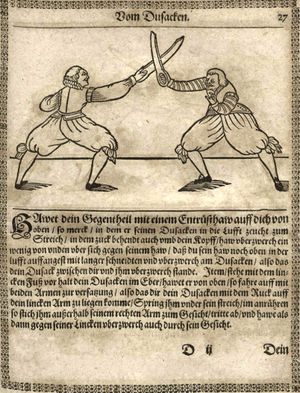I dunno, the Meyer ones all have a particular shape at the end (sharp, with a little sharp counter curve, almost like a scimitar).
Well, as long as you can thrust with it...
I agree, Meyer's depictions look like this (but remember, they've based the stances an animations on Meyer, weapon models are a different thing, see below).
While they look like this on a whole bunch of illustrations, they were also depicted like so:
And Jakub Sutor shows an even more exaggerated blade, like this:
The latter rendition seems to be a popular choice for HEMA clubs when it comes to training weapons. I think it's a pretty versatile design
which lets you practice a variety of cuts and defenses. Funny thing is some shops go as far as to make "premium" (but still wooden) versions of those:
http://www.macdonaldarms.com/armoury/DusacksOfDistinction.php
So, why wouldn't you model them exactly after Mayer? Let's say you picked this illustration for the longsword, this one's not Meyer, but his will look similar.
It's not an actual fighting sword, but a Federschwert - a training weapon that is blunted and has a safe tip for sparring.
I think the problem with modeling weapons after fighting treatises is that it's hard to tell when some features are or are not exaggerated on purpose, or perhaps there is some sort of a skill issue with the drafter.
Overall, I believe it's a much safer bet would be to base the models on actual pieces from museum collections and even then, you're taking a gamble, cause there's no way to tell if such a design was widespread,
heck, if this particular implement was even used for fighting, because a lot of those are impractical, ceremonial pieces.
In the end, some collector items are valuable exactly because of being out of the ordinary.
I think it's down to the rule of cool. The devs thought that particular style of the Sinclair Sabre looks cool, so that's what they went with.
Like everything in the era before mass production you would have all kinds of variety. Some of these types remind me of cavalry sabers, for example:
I'm inclined to believe that "dussack" was pretty much a german catch-all for this type of curved blade (and even then, the curvature could be all over the place),
in some other german manuscript the word was used to describe turks fighting with sabers.


























